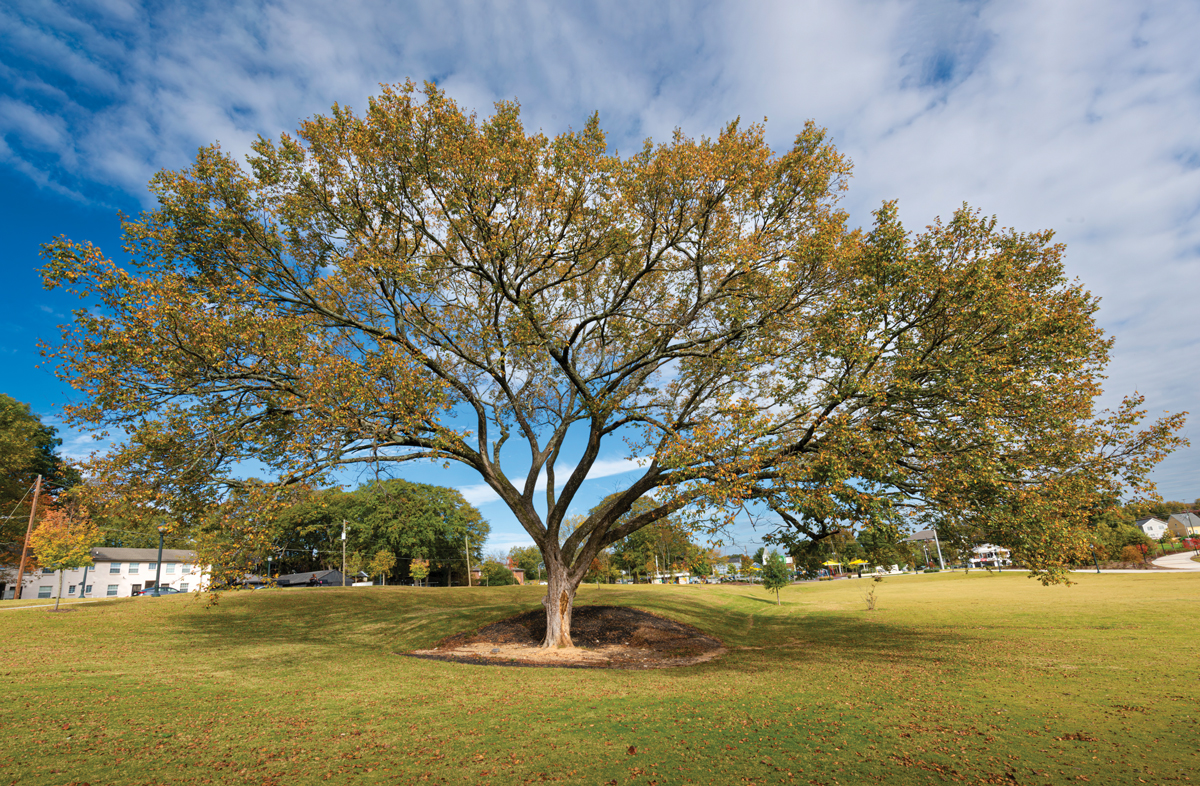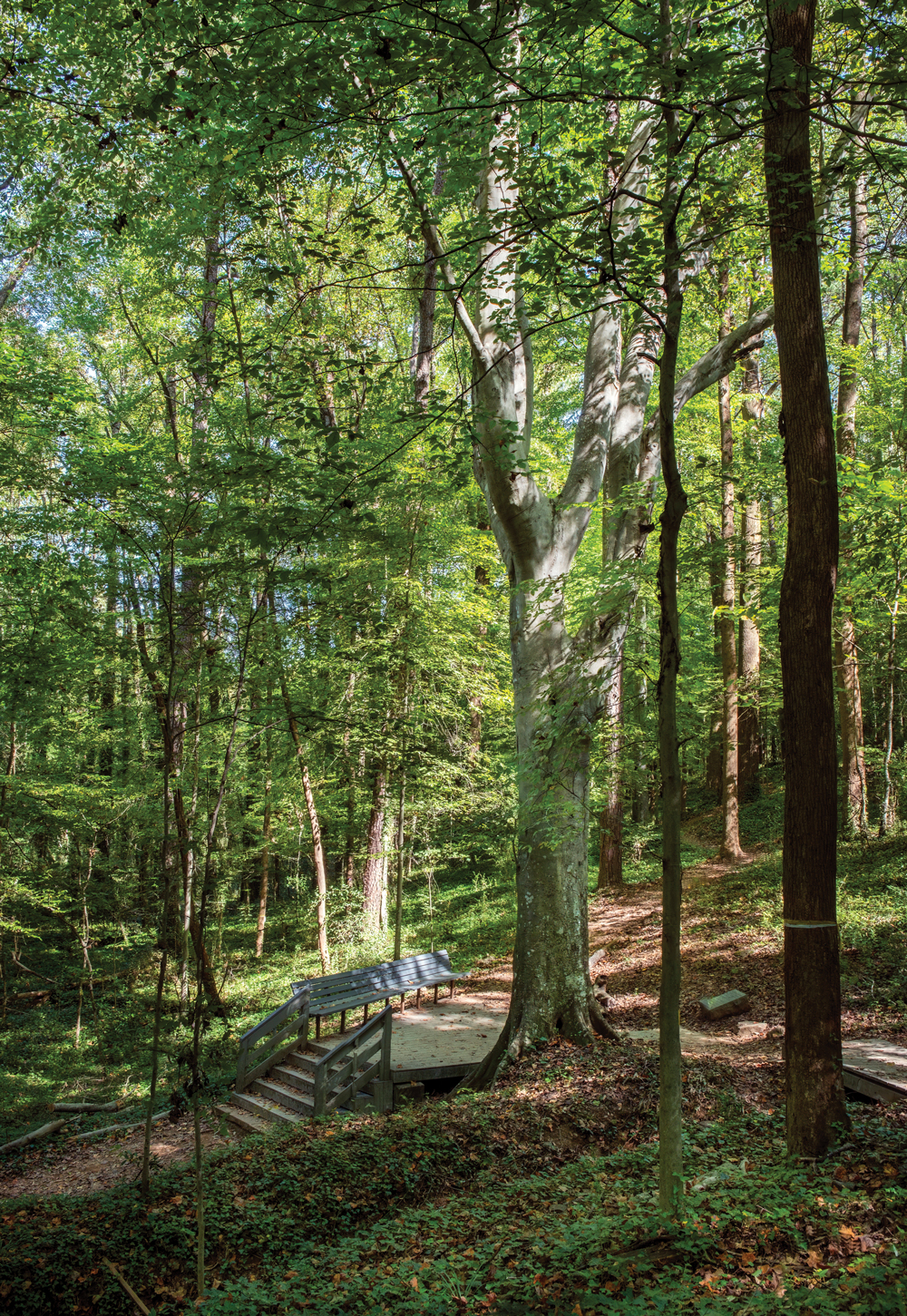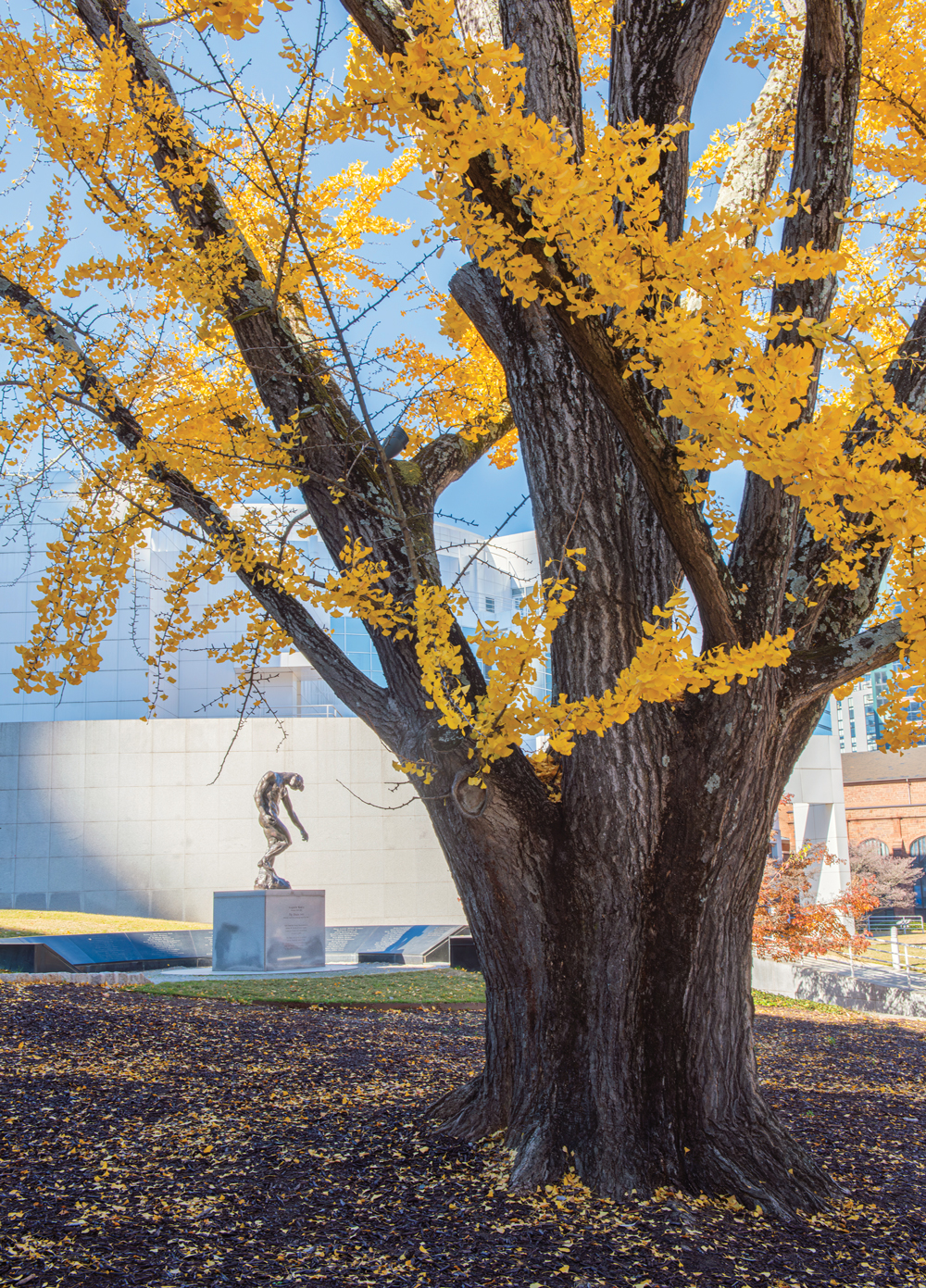{Photograph} by Virginie Kippelen
Incense Cedar
(Libocedrus decurrens)
Agnes Scott Faculty
Circ: 93.7”
Peak: 71.9’
Cover unfold: 30’
Rank: 1
Factors: 173.1
Public entry
This tree, native to California, is the one one in every of its form recognized to exist within the Atlanta space. No person is aware of precisely how the “thriller incense cedar” bought right here, nor who planted it, greater than 180 years in the past—many years earlier than the Civil Conflict.
In a tradition obsessive about competitors, it comes as no shock that even our timber have been put to the check. In 1940, the group American Forests, in an effort to spice up public curiosity in its discipline, started looking the nation for the biggest specimen of every tree species. This venture launched the Nationwide Champion Tree program, an unique honor bestowed upon the USA’ largest timber. States and cities quickly adopted with initiatives to reward their very own tallest and widest residing residents.
Nationwide, just one Georgia tree has managed to crack the highest 500: a reside oak in Clarke County that additionally holds the document for largest crown, spreading a whopping half an acre at its high. However Atlanta—dwelling to the best share of city tree cover within the nation—retains its personal tally of native champions. The nonprofit Park Pleasure started the Atlanta Champion Bushes listing within the Nineties; it’s now maintained by Bushes Atlanta, which depends on workers and volunteers to observe current winners and consider new candidates. Greater than 300 timber, masking 120 species, have made the listing. Extra are nominated yearly: Bushes Atlanta declares the newcomers at its annual Georgia Arbor Day celebration in February.
To separate the champions from the merely giant, arborists depend on a degree system based mostly on a tree’s circumference, peak, and cover unfold. One level is awarded per inch circumference, one level per foot in peak, and 1 / 4 level for each foot in common crown unfold. Every species is ranked individually, so {that a} squat spicebush (Atlanta Champion, 21 toes tall) shouldn’t be measured in opposition to a towering basswood (Atlanta Champion, 132 toes tall).
Although many champion timber have been standing for many years and even centuries, they aren’t essentially town’s oldest timber. “It doesn’t imply prettiest. It doesn’t imply it has historic significance,” says Eli Dickerson, director of schooling at Park Pleasure and a longtime investigator for this system. “It merely means, by these three measurements and this level system, it has essentially the most factors.”
Champion timber don’t experience glory without end. A tree can lose its champion standing when a bigger specimen is found, knocking it from the listing. A big variety of successful timber die yearly, from previous age or, sadly, human intervention; champion standing doesn’t give these timber any further authorized safety.
In honor of Earth Month, celebrated each April, this sequence paperwork a handful of Atlanta’s champion timber—simply a number of the towering neighbors with whom we share our metropolis. Many of those timber are true survivalists, hanging on amid the inhospitable circumstances of an ever-expanding metropolis. They reside astride busy roads, just like the ginkgo in entrance of the Excessive Museum of Artwork, or tucked between homes in dense neighborhoods, within the case of the champion tupelo. Their dimension makes them notable, however they’re maybe most outstanding just because they’ve stayed alive.
“Atlanta has grown and altered throughout the time these timber have grown,” says Alex Beasley, Bushes Atlanta’s director of planting. “Their survival highlights the inherent resilience of nature.”

{Photograph} by Virginie Kippelen
American elm
(Ulmus americana)
641 Thurmond Avenue NW
Circ: 150”
Peak: 65’
Cover Unfold: 110’
Rank: 1
Factors: 242.5
Public entry
Elms had been as soon as a number of the most typical timber throughout the jap United States, however within the mid-Twentieth century the inhabitants was decimated by Dutch elm illness. This wonderful specimen sits on a delicate hill within the Vine Metropolis neighborhood. Throughout park development in 2017, it acquired essential protecting remedy because of its champion standing to make sure it was saved.

{Photograph} by Virginie Kippelen
White ash
(Fraxinus americana)
Louise G. Howard Park
Circ: 171.6”
Peak: 129’
Cover unfold: 56.3’
Rank: 1
Factors: 314.7
Public entry
This tree is one in every of Atlanta’s few champions that additionally holds the title statewide. Widespread white ash is called “poor man’s oak” since it may be substituted for the dearer hardwood. This specific tree is distinctively large for its species. It may be seen leaning over the paved path parallel to Tanyard Creek. As a result of it’s suffered lightning strikes and been besieged by invasive emerald ash borer bugs, arborists fear it might not be round for much longer.

{Photograph} by Virginie Kippelen
Beech
(Fagus grandifolia)
West Atlanta Watershed Alliance Out of doors Exercise Heart
Circ: 136”
Peak: 120.5’
Cover unfold: 90’
Rank: 3
Factors: 279
Public entry
Often known as the “Grandfather Beech Tree,” this specimen dates again to 1863. A platform and a bench enable guests to ponder its towering limbs and clean, silvery-gray bark. Its longevity could also be aided by its proximity to many different mature timber on this 26-acre nature protect, which options one of many few old-growth forest remnants in Atlanta.

{Photograph} by Virginie Kippelen
Southern Magnolia
(Magnolia grandiflora)
Decatur Recreation Heart
There is no such thing as a lack of champion Southern magnolias inside Atlanta’s perimeter. Even when the grandiflora species shouldn’t be native to the Piedmont forest, it stays an everlasting native favourite. This tree, positioned close to the Decatur library, is a brand new contender to affix the listing of Atlanta’s champion magnolias; arborists will take cautious measurements and decide its standing later this 12 months. Its distinctive low branches have hosted generations of climbing kids.

{Photograph} by Virginie Kippelen
Cherrybark oak
(Quercus pagoda)
Our Girl of Perpetual Hope Most cancers House
Circ: 276”
Peak: 102’
Cover unfold: 130’
Rank: 1
Factors: 410.5
Public entry with permission from the hopsice
The Dominican nuns who run this hospice dwelling for terminally ailing most cancers sufferers have lavished this tree with care, and it thrives at this time. The hospice, constructed within the Seventies, was constructed across the tree in an L-shape, permitting residents to get pleasure from it from their home windows. It is likely one of the largest measured timber in Atlanta.

{Photograph} by Virginie Kippelen
Swamp titi
(Cyrilla racemiflora)
Fernbank Science Heart
Circ: 30”
Peak: 12’
Cover unfold: 24’
Rank: 1
Factors: 48
Public entry
This titi swarms with pollinators in spring and summer season. It’s thought to have been planted on a whim by a Fernbank horticulturist when the middle opened in 1967. Thirty years in the past, workers members had been eradicating invasive vegetation from the entrance yard after they found the tree, which had been dwarfed by bigger neighbors for years. It’s now a part of Fernbank’s climate-resilient demonstration backyard, which highlights vegetation native to the Southeast for ecological conservation.

{Photograph} by Virginie Kippelen
Black tupelo
(black gum) (Nyssa sylvatica)
622 Moreland Avenue NE
Circ: 110”
Peak: 90’
Cover unfold: 45’
Rank: 2
Factors: 211.3
Personal residence
This black tupelo, in a personal yard in Poncey-Highland, is flanked by homes however is seen from the road. Comparatively small in comparison with different timber, it’s large for its species. “I loopy love this tree,” says Greg Levine, govt director at Bushes Atlanta. “It has been on our listing for nearly twenty years and it nonetheless stands tall and has stunning fall colours.”

{Photograph} by Virginie Kippelen
Sugarberry
(Celtis laevigata)
The Youngsters’s College
Circ: 203”
Peak: 71’
Cover unfold: 106’
Rank: 1
Factors: 300.5
Personal property
“This sugarberry is exceptionally giant for its species and sure survived as a boundary tree alongside a now-abandoned alley,” says Anna Hauser, an arborist and father or mother of a Youngsters’s College scholar, who nominated the sugarberry. With a cover unfold of 106 toes, it’s 7 toes wider than the present nationwide champion, making it a contender for a much bigger award.

{Photograph} by Virginie Kippelen
Ginkgo
(Ginkgo biloba)
Excessive Museum of Artwork
Circ: 186”
Peak: 90.2’
Cover unfold: 86’
Rank: 1
Factors: 297.7
Public entry
This ginkgo is a crowd-pleaser for museumgoers and passersby alike, particularly within the fall, when its leaves flip a Van Gogh–worthy yellow. Close by renovations, air pollution, and concrete life have careworn its well being for many years, however it’s nonetheless standing.
This text seems in our April 2025 difficulty.
Commercial

